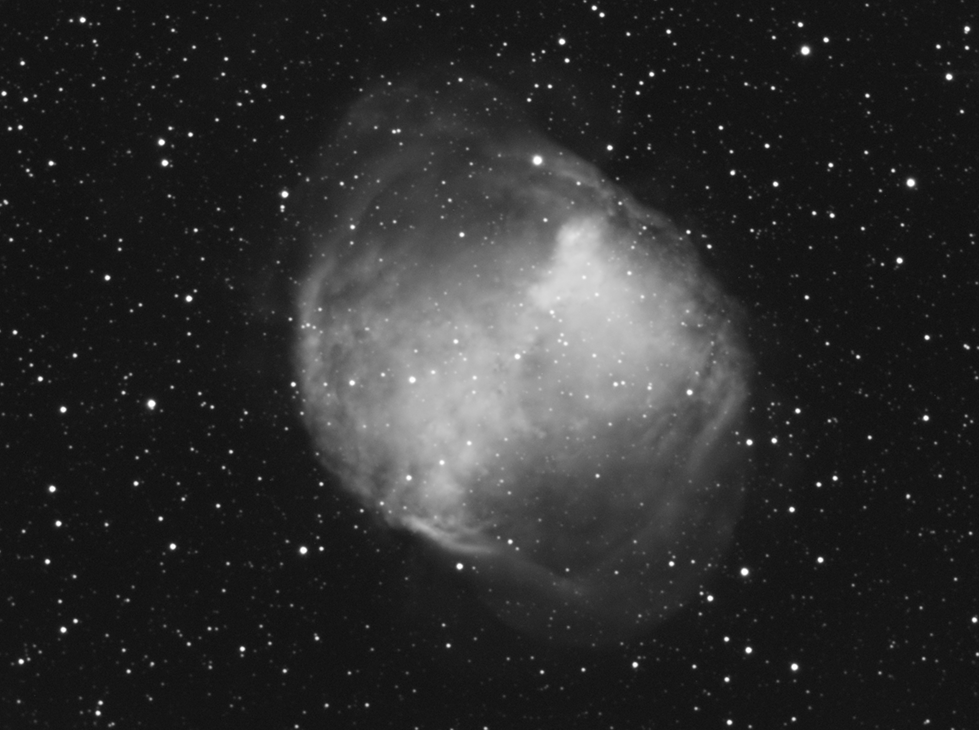Mercury transiting the Sun, taken with a Canon T3i camera through an Orion 8" f/5 Newtonian telescope with Baader solar filter, May 9, 2016. Plenty of clouds were passing overhead, but now and then I had enough of a chance to catch the planet through them. Nice sunspot group above, too. To see the full image, click here.
May 9, 2016
May 8, 2016
M57, M27, Palomar 14, NGC 5005, NGC 6210 (May 2016)
Last week we were blessed with three clear nights, and I was able to image on two of them! Here are the results. All were taken with the CFF 290 Classical Cassegrain at f/7.93. The Astro-Physics CCDT67 brings the effective focal length down from f/13.5 to almost exactly 2300mm. The camera is an SXVF-H9, and I shoot through an Astronomik CLS filter. Guiding is done with an OAG and SX Lodestar on a Tak NJP.
M57 is a favorite of mine. I was still up imaging when it rose high enough, so I thought I'd see what I could get. Now I'm excited to image it with a color camera at this focal length. I've never imaged at this focal length, of course. This image is 16x240". M57 is found in Lyra.
M27 is now also on the color list. Nice to see the close up view. This image is 11x360" and is shrunk to 70% of original because the seeing did not warrant the larger size. M27 is found in Vulpecula.
This is Palomar 14, a globular cluster floating well outside of the Milky Way Galaxy. It lies right in the middle of this image. It's brightest stars (one or two) are around magnitude 18, and I can find several in this image that are magnitude >19. Still, I can only count around 15 stars near the center of this image that I believe are cluster members, based on studies I have read. Palomar 14 is notoriously difficult to observe. The bulk of its stars are >22 magnitude. The cluster was discovered in 1958 on photographic plates. This image is just 10x600" and is inverted so that the very dim stars are easier to see. It could use another four hours, perhaps, and a darker location than my backyard. Palomar 14 is found in Hercules.
NGC 5005 is a galaxy in Canes Venatici. I like its grand spiral design, and I find a slight bar in the center, based on measurements of its brighter bulge. It's outer parts are very dim, and I have stretched the image to see them. Several other galaxies can be found in the image. This image is 17x720".
NGC6210 is a planetary nebula in Hercules. The image is just 4x4" + 25x8" = 216 seconds, just over three minutes. The nebula is quite bright. The faintest stars in the image are dimmer than magnitude 15.
M57 is a favorite of mine. I was still up imaging when it rose high enough, so I thought I'd see what I could get. Now I'm excited to image it with a color camera at this focal length. I've never imaged at this focal length, of course. This image is 16x240". M57 is found in Lyra.
M27 is now also on the color list. Nice to see the close up view. This image is 11x360" and is shrunk to 70% of original because the seeing did not warrant the larger size. M27 is found in Vulpecula.
This is Palomar 14, a globular cluster floating well outside of the Milky Way Galaxy. It lies right in the middle of this image. It's brightest stars (one or two) are around magnitude 18, and I can find several in this image that are magnitude >19. Still, I can only count around 15 stars near the center of this image that I believe are cluster members, based on studies I have read. Palomar 14 is notoriously difficult to observe. The bulk of its stars are >22 magnitude. The cluster was discovered in 1958 on photographic plates. This image is just 10x600" and is inverted so that the very dim stars are easier to see. It could use another four hours, perhaps, and a darker location than my backyard. Palomar 14 is found in Hercules.
NGC 5005 is a galaxy in Canes Venatici. I like its grand spiral design, and I find a slight bar in the center, based on measurements of its brighter bulge. It's outer parts are very dim, and I have stretched the image to see them. Several other galaxies can be found in the image. This image is 17x720".
NGC6210 is a planetary nebula in Hercules. The image is just 4x4" + 25x8" = 216 seconds, just over three minutes. The nebula is quite bright. The faintest stars in the image are dimmer than magnitude 15.
Subscribe to:
Comments (Atom)





